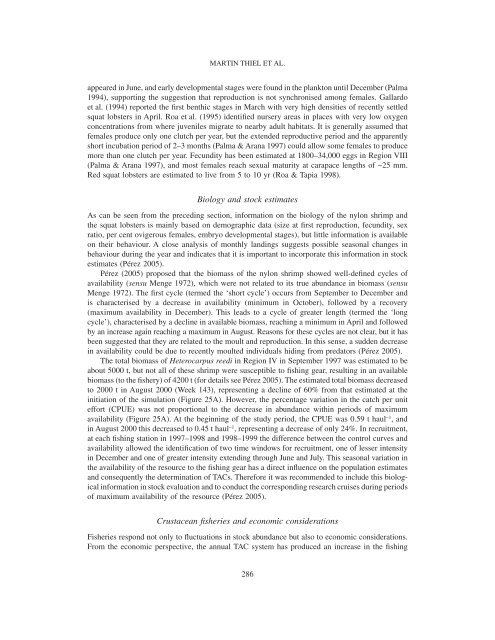the humboldt current system of northern and central chile - figema
the humboldt current system of northern and central chile - figema
the humboldt current system of northern and central chile - figema
You also want an ePaper? Increase the reach of your titles
YUMPU automatically turns print PDFs into web optimized ePapers that Google loves.
MARTIN THIEL ET AL.appeared in June, <strong>and</strong> early developmental stages were found in <strong>the</strong> plankton until December (Palma1994), supporting <strong>the</strong> suggestion that reproduction is not synchronised among females. Gallardoet al. (1994) reported <strong>the</strong> first benthic stages in March with very high densities <strong>of</strong> recently settledsquat lobsters in April. Roa et al. (1995) identified nursery areas in places with very low oxygenconcentrations from where juveniles migrate to nearby adult habitats. It is generally assumed thatfemales produce only one clutch per year, but <strong>the</strong> extended reproductive period <strong>and</strong> <strong>the</strong> apparentlyshort incubation period <strong>of</strong> 2–3 months (Palma & Arana 1997) could allow some females to producemore than one clutch per year. Fecundity has been estimated at 1800–34,000 eggs in Region VIII(Palma & Arana 1997), <strong>and</strong> most females reach sexual maturity at carapace lengths <strong>of</strong> ~25 mm.Red squat lobsters are estimated to live from 5 to 10 yr (Roa & Tapia 1998).Biology <strong>and</strong> stock estimatesAs can be seen from <strong>the</strong> preceding section, information on <strong>the</strong> biology <strong>of</strong> <strong>the</strong> nylon shrimp <strong>and</strong><strong>the</strong> squat lobsters is mainly based on demographic data (size at first reproduction, fecundity, sexratio, per cent ovigerous females, embryo developmental stages), but little information is availableon <strong>the</strong>ir behaviour. A close analysis <strong>of</strong> monthly l<strong>and</strong>ings suggests possible seasonal changes inbehaviour during <strong>the</strong> year <strong>and</strong> indicates that it is important to incorporate this information in stockestimates (Pérez 2005).Pérez (2005) proposed that <strong>the</strong> biomass <strong>of</strong> <strong>the</strong> nylon shrimp showed well-defined cycles <strong>of</strong>availability (sensu Menge 1972), which were not related to its true abundance in biomass (sensuMenge 1972). The first cycle (termed <strong>the</strong> ‘short cycle’) occurs from September to December <strong>and</strong>is characterised by a decrease in availability (minimum in October), followed by a recovery(maximum availability in December). This leads to a cycle <strong>of</strong> greater length (termed <strong>the</strong> ‘longcycle’), characterised by a decline in available biomass, reaching a minimum in April <strong>and</strong> followedby an increase again reaching a maximum in August. Reasons for <strong>the</strong>se cycles are not clear, but it hasbeen suggested that <strong>the</strong>y are related to <strong>the</strong> moult <strong>and</strong> reproduction. In this sense, a sudden decreasein availability could be due to recently moulted individuals hiding from predators (Pérez 2005).The total biomass <strong>of</strong> Heterocarpus reedi in Region IV in September 1997 was estimated to beabout 5000 t, but not all <strong>of</strong> <strong>the</strong>se shrimp were susceptible to fishing gear, resulting in an availablebiomass (to <strong>the</strong> fishery) <strong>of</strong> 4200 t (for details see Pérez 2005). The estimated total biomass decreasedto 2000 t in August 2000 (Week 143), representing a decline <strong>of</strong> 60% from that estimated at <strong>the</strong>initiation <strong>of</strong> <strong>the</strong> simulation (Figure 25A). However, <strong>the</strong> percentage variation in <strong>the</strong> catch per uniteffort (CPUE) was not proportional to <strong>the</strong> decrease in abundance within periods <strong>of</strong> maximumavailability (Figure 25A). At <strong>the</strong> beginning <strong>of</strong> <strong>the</strong> study period, <strong>the</strong> CPUE was 0.59 t haul −1 , <strong>and</strong>in August 2000 this decreased to 0.45 t haul −1 , representing a decrease <strong>of</strong> only 24%. In recruitment,at each fishing station in 1997–1998 <strong>and</strong> 1998–1999 <strong>the</strong> difference between <strong>the</strong> control curves <strong>and</strong>availability allowed <strong>the</strong> identification <strong>of</strong> two time windows for recruitment, one <strong>of</strong> lesser intensityin December <strong>and</strong> one <strong>of</strong> greater intensity extending through June <strong>and</strong> July. This seasonal variation in<strong>the</strong> availability <strong>of</strong> <strong>the</strong> resource to <strong>the</strong> fishing gear has a direct influence on <strong>the</strong> population estimates<strong>and</strong> consequently <strong>the</strong> determination <strong>of</strong> TACs. Therefore it was recommended to include this biologicalinformation in stock evaluation <strong>and</strong> to conduct <strong>the</strong> corresponding research cruises during periods<strong>of</strong> maximum availability <strong>of</strong> <strong>the</strong> resource (Pérez 2005).Crustacean fisheries <strong>and</strong> economic considerationsFisheries respond not only to fluctuations in stock abundance but also to economic considerations.From <strong>the</strong> economic perspective, <strong>the</strong> annual TAC <strong>system</strong> has produced an increase in <strong>the</strong> fishing286










